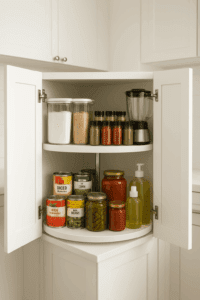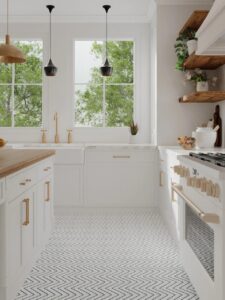Every kitchen has them – those frustrating corner areas that seem to swallow items whole, never to be seen again. Kitchen corner dead space represents one of the biggest missed opportunities in home design, where valuable square footage goes completely unused or becomes a chaotic dumping ground for forgotten items. If you’ve ever lost a pot in the back corner of a cabinet or avoided using corner storage because it’s too difficult to access, you understand the kitchen corner dead space problem intimately.
The challenge with kitchen corner dead space isn’t just about storage capacity – it’s about creating functional, accessible storage that actually gets used. Traditional corner cabinets often create more problems than they solve, with deep recesses that are impossible to see into and awkward angles that make retrieval nearly impossible. The good news is that modern storage solutions have evolved specifically to address these challenges, transforming dead corner space into some of your kitchen’s most valuable real estate.
Understanding Why Kitchen Corner Dead Space Happens
Kitchen corner dead space occurs primarily because standard cabinetry and storage solutions are designed for straight runs and right angles. When these rectangular systems meet at corners, they create triangular zones that don’t accommodate standard storage methods. Traditional approaches often ignore these spaces entirely or create storage that’s technically present but practically inaccessible.
The depth of corner cabinets compounds the problem. While a 24-inch deep corner cabinet might seem spacious, the reality is that anything placed more than 12 inches from the opening becomes difficult to reach and virtually invisible during daily use. This creates a zone of dead space where items go to disappear, effectively removing storage capacity rather than adding it.
Another factor contributing to kitchen corner dead space is the lack of visibility and organization systems designed for corner applications. Standard shelving and storage accessories work poorly in corner environments, leading to chaotic stacking and inevitable avalanches when you try to retrieve something from the back.
Revolutionary Solutions for Corner Dead Space
Professional-Grade Pull-Out Systems
The most effective solution for eliminating kitchen corner dead space involves installing professional-grade pull-out systems designed specifically for corner applications. Systems like the VADANIA Blind Corner Pull Out Organizer transform inaccessible corner storage into fully functional, easily accessible space. These mechanisms use sophisticated sliding and pivoting actions to bring the entire corner contents out into your kitchen workspace.
What makes these systems revolutionary is their ability to provide full access to corner storage without the limitations of traditional lazy Susan systems. The two-tier design maximizes vertical space while maintaining easy access to both levels. The soft-close feature ensures smooth, quiet operation that won’t slam or stick over time.
The installation process, while requiring some cabinet modification, provides dramatic improvements in storage accessibility and capacity. Unlike simple organizational accessories, these systems actually change how corner space functions, eliminating dead zones entirely.
Advanced Lazy Susan Systems
While pull-out systems represent the cutting edge of corner storage, advanced lazy Susan systems remain highly effective solutions for kitchen corner dead space. Modern lazy Susan turntables like this highly-rated rotating organizer offer smooth operation and thoughtful design that addresses many traditional lazy Susan limitations.
The key advantage of quality lazy Susan systems is their ability to bring items from any point in the corner directly to the cabinet opening with simple rotation. This eliminates the reaching and groping associated with traditional corner storage while maintaining full visibility of stored items.
Contemporary lazy Susan designs incorporate features like non-slip surfaces, raised edges to prevent items from sliding off, and heavy-duty bearings that ensure smooth operation even under substantial weight loads.
Custom Corner Drawer Systems
For new construction or major renovations, custom corner drawer systems represent the ultimate solution to kitchen corner dead space. These systems use angled drawers that slide out at optimal angles for corner access, providing drawer-style organization in corner applications.
Corner drawer systems excel at storing heavy items like pots, pans, and small appliances because the sliding mechanism handles weight better than rotating systems. The drawer format also provides better organization options with dividers, compartments, and customizable layouts.
DIY Solutions for Corner Dead Space
Strategic Shelving Approaches
Not every kitchen corner dead space solution requires professional installation or expensive hardware. Strategic shelving can dramatically improve corner storage accessibility while working within existing cabinet structures. The key is choosing shelf configurations that bring items forward rather than pushing them deeper into corner recesses.
Tiered shelf systems work particularly well in corner applications. By creating multiple levels at different depths, you maintain visibility and accessibility while maximizing storage capacity. Items used most frequently should occupy the most accessible shelf positions, with seasonal or occasional-use items relegated to less convenient but still reachable locations.
Corner-specific shelving accessories can adapt standard shelving to corner applications more effectively than trying to force rectangular solutions into triangular spaces.
Organizational Systems That Work
Simple organizational systems can transform kitchen corner dead space without requiring major modifications. The secret lies in choosing systems that work with corner geometry rather than fighting against it.
Curved storage bins that follow corner contours waste less space than rectangular containers while providing better access. Stackable systems allow you to build storage vertically while maintaining the ability to access lower levels without removing everything above.
Labeling systems become crucial in corner applications where items might not be immediately visible. Clear containers and consistent labeling ensure that corner storage remains functional rather than becoming a mystery zone.
Pull-Out Bin Solutions
Simple pull-out bins can provide many of the benefits of professional pull-out systems at a fraction of the cost. These systems use standard drawer slides mounted to cabinet floors or shelves, allowing bins or baskets to extend fully outside the cabinet for complete access.
DIY pull-out systems work particularly well for lightweight storage like cleaning supplies, pantry items, or kitchen linens. While they don’t provide the sophisticated mechanisms of professional systems, they eliminate the accessibility problems that create corner dead space.
Maximizing Corner Storage Efficiency
The Zone System Approach
Effective corner storage requires strategic thinking about what items belong in corner locations. The zone system approach designates specific corner areas for related items while considering frequency of use and storage requirements.
High-frequency zones should occupy the most accessible corner positions, while medium and low-frequency items can utilize less convenient but still functional areas. This approach ensures that corner storage enhances rather than hinders daily kitchen activities.
Consider creating themed zones within corner storage – a baking zone with all related ingredients and tools, a cleaning zone with supplies and equipment, or an entertaining zone with serving pieces and special occasion items.
Inventory Management for Corners
Kitchen corner dead space often develops because items accumulate without regular evaluation. Implementing inventory management systems prevents corners from becoming dumping grounds for unused or forgotten items.
Regular inventory sessions help identify items that don’t belong in corner storage and reveal opportunities for better organization. The goal is maintaining corner storage as active, functional space rather than long-term storage that creates dead zones.
Consider implementing a “one in, one out” policy for corner storage to prevent accumulation and maintain organization over time.
Accessibility Testing
Any corner storage solution should pass the accessibility test – can you easily reach and retrieve items during normal kitchen activities? Solutions that require significant effort, special tools, or awkward positioning will eventually be abandoned, recreating dead space problems.
Test corner storage solutions with realistic loads and typical usage patterns before finalizing installations. What seems accessible when empty might become problematic when fully loaded with typical kitchen items.
Common Mistakes That Create More Dead Space
Over-Engineering Solutions
One common mistake when addressing kitchen corner dead space is choosing overly complex solutions that create new problems. Systems that require multiple steps to access, have numerous moving parts, or need frequent maintenance often end up unused, recreating the dead space they were meant to eliminate.
The best corner solutions are simple, reliable, and intuitive to use. Complexity should enhance function, not create barriers to regular use.
Ignoring Weight Considerations
Corner storage solutions must accommodate the weight and size of items you actually store. Installing delicate mechanisms for heavy cookware or choosing weight-limited systems for substantial storage needs leads to failures that recreate dead space problems.
Consider not just current storage needs but potential future requirements when selecting corner solutions. Storage systems should accommodate growth and changing needs rather than limiting options.
Poor Integration with Kitchen Workflow
Corner storage solutions that don’t integrate well with kitchen workflow patterns create their own accessibility problems. Storage should enhance cooking and cleaning activities rather than requiring workflow interruptions or awkward movements.
Consider how corner storage integrates with adjacent work areas, appliance locations, and traffic patterns. The best solutions feel natural and intuitive within your specific kitchen layout and usage patterns.
Budget-Conscious Corner Solutions
Phased Implementation Strategies
Transforming kitchen corner dead space doesn’t require massive upfront investments. Phased implementation allows you to address the most problematic areas first while spreading costs over time and learning what works best in your specific situation.
Start with simple organizational improvements and graduate to more sophisticated solutions as budget allows and as you identify what approaches work best for your storage needs and usage patterns.
Cost-Effective Professional Options
Professional corner storage solutions vary dramatically in cost, with some options providing excellent value for their functionality. Research carefully and consider long-term value rather than just initial cost when evaluating options.
Sometimes investing in one high-quality professional solution for the most problematic corner provides better overall value than multiple lower-cost attempts that don’t fully solve accessibility problems.
ROI Considerations for Kitchen Improvements
Corner storage improvements often provide excellent returns on investment, both in daily functionality and potential home value. Dead space elimination is one of the most appreciated improvements among homeowners and potential buyers.
Consider corner improvements as investments in daily quality of life rather than just storage solutions. The time and frustration saved by accessible corner storage compounds over years of daily use.
Maintenance and Long-Term Success
Keeping Corner Solutions Functional
Corner storage solutions require ongoing maintenance to remain effective over time. Moving mechanisms need periodic cleaning and lubrication, while organizational systems need regular attention to prevent chaos from creeping back in.
Establish maintenance routines that keep corner storage systems operating smoothly. This includes both mechanical maintenance for moving parts and organizational maintenance to prevent clutter accumulation.
Adapting to Changing Needs
Kitchen storage needs evolve over time, and corner solutions should be adaptable to changing requirements. Consider how solutions might be modified or upgraded rather than selecting permanent installations that can’t evolve.
Modular approaches often provide better long-term value by allowing modifications without complete replacement when needs change.
Family Training and Adoption
The best corner storage solutions in the world won’t eliminate dead space if family members don’t understand and use them properly. Take time to train household members on how systems work and why maintaining organization matters.
Create simple guidelines for corner storage use and make systems intuitive enough that following guidelines becomes natural rather than burdensome.
Measuring Success: Before and After
Functionality Metrics
Successful elimination of kitchen corner dead space should be measurable in practical terms. Can you find and retrieve any item in corner storage within 30 seconds? Can you see everything stored in corner areas without moving other items? These practical metrics indicate whether solutions truly eliminate dead space.
Track how often you actually use corner storage areas. Increased usage indicates successful dead space elimination, while continued avoidance suggests solutions aren’t working as intended.
Space Utilization Analysis
Measure how much of your corner storage space is actually being used effectively. Dead space isn’t just inaccessible areas – it’s also space that’s technically reachable but practically unused due to poor organization or difficult access.
Successful corner solutions should dramatically increase the percentage of corner space that’s actively used for storage rather than simply providing more places to lose things.
Daily Impact Assessment
The ultimate measure of corner storage success is its impact on daily kitchen activities. Do meal preparation, cooking, and cleanup feel easier and more efficient? Are you spending less time looking for items or struggling with storage access?
Consider both direct impacts (easier access to stored items) and indirect impacts (more counter space due to better storage, reduced frustration with kitchen organization) when evaluating corner solutions.
Kitchen corner dead space represents one of the most solvable problems in kitchen design. With the right combination of storage solutions, organizational strategies, and maintenance approaches, these problematic areas can become some of your kitchen’s most valuable assets. Whether you choose professional installation of sophisticated pull-out systems, implement advanced lazy Susan solutions, or take a DIY approach with strategic improvements, the key is addressing corner storage systematically rather than accepting dead space as inevitable.
The investment in proper corner storage solutions pays dividends in daily convenience, reduced frustration, and improved kitchen functionality. Don’t let valuable corner space remain dead – transform it into the accessible, organized storage your kitchen deserves.
This article contains affiliate links, which means we may earn a small commission at no extra cost to you if you click through and make a purchase.


